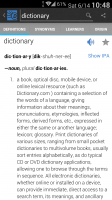Fine, that all makes sense. I understand it's a business, and thanks for taking the time to explain rather than making me read through the beta threads. Yes, I know that Android is anti-one-handed, for no particularly good reason (controls always at the top rather than the bottom), and now we're stuck with having to maintain consistency for today's average user.
There's another angle of view on this same story: UI bloat. Adding options to hide never-used, entirely unwanted control items would take care of it. Let me explain. Pleco always opens to the two-panel window with the keyboard open. On my S4, I never use the standalone definition screen--ever. I see a whole lot of stuff in two-panel mode, and there's no reason to go switching to other defintion views on this full-sized phone. In fact, I don't even see right now how to get to the definition window in 3.1--but I don't care: it's an extra step that would slow down real-time operation. So I now encounter a whole bunch of useless stuff eating a large portion of the screen 100% of the time that I'm using the dictionary. Yes, there's the unergonomic aspect, which makes those control items unreachable under most conditions (I'm always carrying a bag), but quite frankly I don't even use SCW, except maybe once a month, let alone 'D' which is now totally deprecated, and 'E' which is useless to me. And I never select a different input method since I'm in the category of the fluent speaker who's 100% pinyin.
So, in real time usage, I'm always looking at two-panel mode with keyboard open using Pleco's #1 core functionality: it's a dictionary before anything else, right? Yet, that dictionary functionality is degraded by the nifty bells and whistles. Attending to ergonomics would have at least made those bells and whistles available for me, but quite frankly I just don't want those bells and whistles. Ergonomics is an issue, and you're intentionally designing it out because you're saying you're handcuffed by Google groupthink and need to show the average user consistency as Google defines it. I see the rationality in that. But at every step I've also added how I hardly even use these features. DSCWE are interesting and educational even for me, but why not provide the unfettered dictionary interface for those who want just that core functionality, defaulted to the user's last selected input method? Provide options to hide the non-core control bars in two-panel mode. Letting the dictionary simply be a dictionary would solve the whole thing, from my point of view. You've convinced me that business considerations outweigh incorporating fine-grained user-settable ergonomic parameters. But even the average user might like options to simply hide the bloat even if they shouldn't be trusted to customize its layout on the screen. Put it under "Miscellaneous" and call it "vanilla dictionary UI." Or, if maintenance cost is a concern, create a category of settings called "Expert," or "Extended," or "Experimental," or whatever, with a "use at your own risk" and a notification that such options will only be maintained on a delayed schedule as company time allows in case they break when the app is updated. That would take the pressure off you without leaving the "extended" users off the upgrade path entirely if they're willing to lag behind. But I really don't want to downgrade to 2.4 and be stuck there forever.

